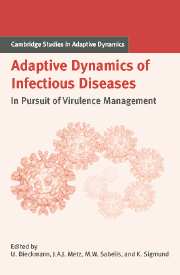Book contents
- Frontmatter
- Contents
- Contributing Authors
- List of Boxes
- Notational Standards
- 1 Introduction
- A Setting the Stage
- B Host Population Structure
- C Within-Host Interactions
- D Pathogen–Host Coevolution
- E Multilevel Selection
- Introduction to Part E
- 20 Weakened from Within: Intragenomic Conflict and Virulence
- 21 Ecology and Evolution of Chestnut Blight Fungus
- 22 Evolution of Exploitation and Defense in Tritrophic Interactions
- F Vaccines and Drugs
- G Perspectives for Virulence Management
- References
- Index
- International Institute for Applied Systems Analysis
Introduction to Part E
Published online by Cambridge University Press: 15 January 2010
- Frontmatter
- Contents
- Contributing Authors
- List of Boxes
- Notational Standards
- 1 Introduction
- A Setting the Stage
- B Host Population Structure
- C Within-Host Interactions
- D Pathogen–Host Coevolution
- E Multilevel Selection
- Introduction to Part E
- 20 Weakened from Within: Intragenomic Conflict and Virulence
- 21 Ecology and Evolution of Chestnut Blight Fungus
- 22 Evolution of Exploitation and Defense in Tritrophic Interactions
- F Vaccines and Drugs
- G Perspectives for Virulence Management
- References
- Index
- International Institute for Applied Systems Analysis
Summary
The implications of multilevel selection for virulence evolution deserve closer attention, especially where selection leads to conflicts of interest between organisms at different organizational levels. In pathogen-host interactions this conflict is selfevident, but in numerous cases parasites have evolved to act as commensalists or even as mutualists. The latter case, however, does not imply that interests exactly match.
In Chapter 20, Hoekstra and Debets consider mutants of mitochondria that slow down the growth of their host, a bread mold fungus. In spite of this apparent disadvantage, these mutants outcompete normal mitochondria in crosses between fungi that contain wild-type and mutant mitochondria. If such crosses occur frequently enough in nature, the resultant intragenomic conflict may lead to the interesting phenomenon that, through the lower-level selection process, fungal hosts with relatively slow growth can increase in frequency in the population. Similar processes can occur via mitochondrial plasmids that cause senescence, a phenomenon normally absent in fungi. The persistence of these obviously harmful plasmids is striking in some genera of fungi; the key to understanding this observation is probably the existence of horizontal transmission by anastomosis between different fungal units. Hoekstra and Debets suggest that, once horizontal transfer is open to manipulation, the performance of fungal diseases could be changed through intragenomic conflict.
Chapter 21 describes the evolutionary dynamics of the tritrophic interaction between chestnut trees, a blight fungus, and a double-stranded RNA virus.
- Type
- Chapter
- Information
- Adaptive Dynamics of Infectious DiseasesIn Pursuit of Virulence Management, pp. 278 - 279Publisher: Cambridge University PressPrint publication year: 2002



